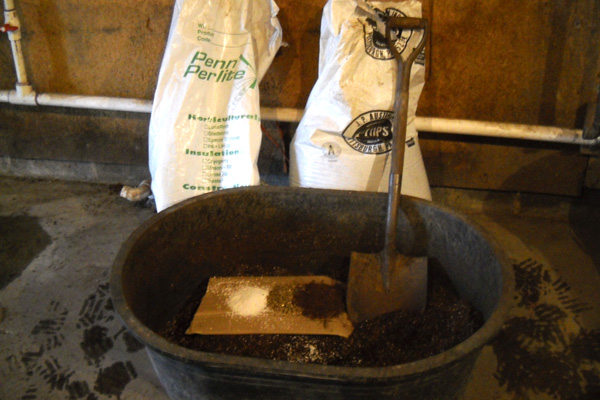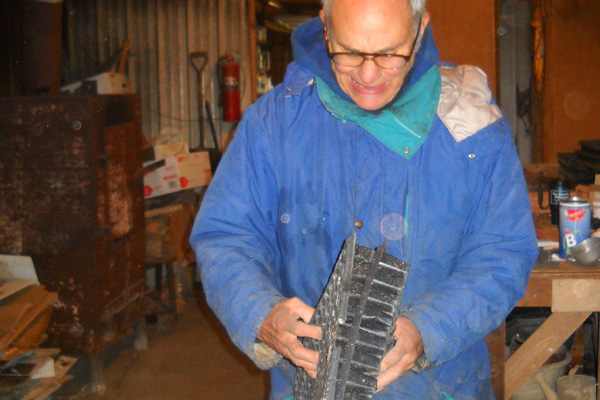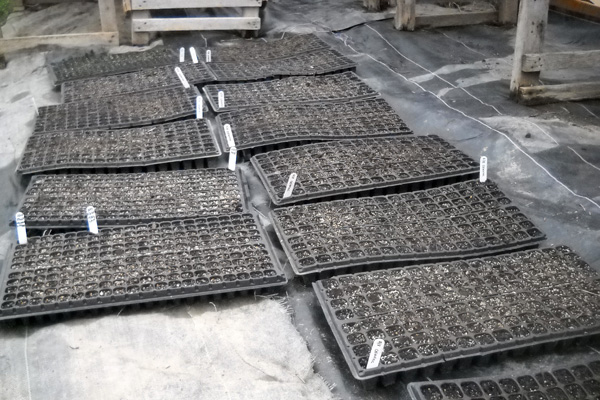Community /
Blogs
The opinions expressed in these blogs are solely those of the people who wrote them, and do not represent the views of WPSU or Penn State University.
Local Food Journey
Farm Diary: Seeding Fun in Late February
Posted by James Eisenstein on 03/07 at 08:59 AM

High-tech infrastructure for making seed-starting mix: perlite, vermiculite, and peat on cardboard. Photo Credit James Eisenstein.
Seeding is a critical component of farming. No seed flats planted in February means no crops later. It is a laborious and painstaking, but oddly, satisfying task that I tackled two weeks ago. Here is how it works.
To begin, you have to prepare the seed starting medium. We use a formula of vermiculite, perlite, peat moss, and compost, blended together in a large tub. Regular soil is too rich and heavy, doesn’t hold water well, and can harbor diseases that harm the seedlings. Twenty minutes of measuring, shifting compost, and mixing produced the first of the two patches.
The mixture is placed in plastic seed flats containing 72, 128, or 200 cells, each about an inch deep. We store the flats stacked one into the other, so they have to be separated. To do this, after 20 seconds of muttering, you manage to lift the end of a flat and begin to lift the edges on both sides. When you manage to get the other end separated and lifted, the end you started with neatly snaps back into the flat below. Repeat your muttering, maybe even utter a gentle curse, and start again.

Depicting my calm, skillful technique for separating seed flats. Photo Courtesy James Eisenstein.
Filling flats is easier. You just hurl the mix into the flat, scrape off the excess with a short board, and press another flat into it to compress the soil, leaving about ¼ inch at the top. I planted two 200 cell flats with eggplant seeds and another two with sweet pepper seeds, three 128 flats with swiss chard, and thirteen 72 cell flats with leeks and onions. We plant five or six onion and leek seeds in each cell. Some don’t germinate, and they will grow nicely even if there are several plants in each cell at transplanting time.
I put seeds in over 2,100 cells. To help pass the time, I put some “Verdi Opera Highlight†CDs in a CD player. John, who was building small boxes for beet seeding in the workroom next to the seeding room, helpfully translated the Italian lyrics as “Visiting relatives is not a vacation.â€

Some of the seeded flats awaiting germination in the greenhouse. Photo Credit James Eisenstein.
If you seed beets directly outdoors and set your hand-pushed seeder to close spacing, you might get good germination. But if you do, it isn’t especially good news. Each beet “seed†actually contains within it several seeds. Good germination results in an unbroken line of seedlings, which then requires time consuming, meticulous hands-and-knees thinning. Anticipating this, you might instead plant the seeds further apart. But then, if germination is poor, you are left with a row with way too few beets, and you still have to thin the seedlings that sprouted from each seed. So we plant them in a box and transplant the seedlings, one by one.
![]() Author: James Eisenstein
Author: James Eisenstein
Bio: Unpaid Field Hand at Jade Family Farm | Former Penn State Professor
Leave a Comment
Commenting is not available in this section entry. « Farms and Customers Gather at Centre County CSA Fair Field Notes: Early March »Most recent entries
 Our Local Food Journey comes to an end
Our Local Food Journey comes to an end- Wednesday, January 31, 2018
- By Jamie Oberdick in Local Food Journey
 Winter isn’t a quiet time at the farm
Winter isn’t a quiet time at the farm- Wednesday, January 31, 2018
- By James Eisenstein in Local Food Journey
 Get the taste of garden season right now by growing herbs indoors
Get the taste of garden season right now by growing herbs indoors- Friday, January 26, 2018
- By Jamie Oberdick in Local Food Journey
 All you need to know about PASA’s Farming for the Future conference
All you need to know about PASA’s Farming for the Future conference- Friday, January 19, 2018
- By Jamie Oberdick in Local Food Journey
Categories
Archives
- January 2018
- December 2017
- November 2017
- October 2017
- September 2017
- August 2017
- July 2017
- June 2017
- May 2017
- April 2017
- March 2017
- February 2017
- January 2017
- December 2016
- November 2016
- October 2016
- September 2016
- August 2016
- July 2016
- June 2016
- May 2016
- April 2016
- March 2016
- February 2016
- January 2016
- December 2015
- November 2015
- October 2015
- September 2015
- August 2015
- July 2015
- June 2015
- May 2015
- April 2015
- March 2015
- February 2015
- January 2015
- December 2014
- November 2014
- October 2014
- September 2014
- August 2014
- July 2014
- June 2014
- May 2014
- April 2014
- March 2014
- February 2014
- January 2014
- December 2013
- November 2013
- October 2013
- September 2013
- August 2013
- July 2013
- June 2013
- May 2013
- April 2013
- March 2013
- February 2013
- January 2013
- December 2012
- November 2012
- October 2012
- September 2012
- August 2012
- July 2012
- June 2012
- May 2012
- April 2012
- March 2012
- February 2012
- January 2012
- December 2011
- November 2011
- October 2011
- September 2011
- August 2011
- July 2011
- June 2011
- May 2011
- April 2011
- March 2011
- February 2011
- January 2011
- December 2010
- November 2010
- October 2010
- September 2010
- August 2010
- July 2010
- June 2010
- May 2010
- April 2010
- March 2010
- February 2010
- January 2010
- December 2009
- November 2009
- October 2009
- September 2009
- August 2009
- July 2009
- June 2009
- May 2009
- April 2009
- March 2009
- February 2009

NO COMMENTS